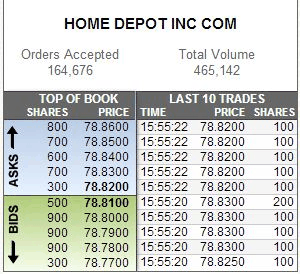Market Action
If you ever get the chance, it can be interesting to see how the pricing mechanism works in practice. You can do this by looking at a “Level II” terminal display, which shows the actual buyers and sellers interested in the market at any particular time. You usually have to subscribe to this, so depending on your type of trading you will probably stick with the regular charts rather than paying extra. Here is a typical display: –
This is for Home Depot, the US-based builders supply store. On the left is a list of the closest “Bids”, which is how much someone is prepared to pay, and the “Asks”, which is how much someone wants to sell for. On the right is a record of the most recent trades that have taken place.
You can see that the highest bid is 78.8100 – someone wants to buy 500 shares at this price, and the lowest ask is 78.8200 – someone else is willing to sell 300 shares at this price. Because the price is not the same, there is no deal. The situation changes from second to second. For instance, if someone came in with a market order to buy 1000 shares, they would get 300 shares at 78.8200 and 700 shares at 78.8300, and this increase in price would be reflected in the “Last 10 Trades” column on the right.
Note also how quickly the prices change. The last 10 trades occurred in 2 seconds, according to the 24-hour clock time shown, and the price varied between 78.8200 and 78.8300 in that time. It takes computers to keep up with the pace of trading.
“It’s almost like investors climb a ‘ladder of enthusiasm’…only for a ‘trap-door’ to open once the majority of the herd get cold feet. Old expression used to echo around the City office blocks. ‘You go up via the stairs, down via the window.’ Probably dates back, rather grimly, to the Wall Street Crash where that happened literally’ in some cases.”
Shorting
Now for a topic that confuses many people. It is the way you make money out of a falling price. It is called going “short”, or “shorting a stock”. You don’t really have to understand the mechanics of it in order to use it, but some people find they can retain an idea better if they know how it works.
In essence, instead of buying a stock, waiting (hopefully) for it to increase in value, and then selling it, you do things the other way around. First you sell a stock, wait (hopefully) for it to decrease in value, and then buy it at the lower price, effectively making a profit of the difference in price. Note that as you sold the stock in the first place, when you finally buy it you are just making the numbers add up, and you don’t finish up owning any stock.
The theory of the way this works in practice is that your broker, who has access to all the accounts he manages, facilitates it by finding some of the shares in the company you are interested in owned by another client, and “borrowing” them. These are the shares that he “sells” on your behalf when you go short on the stock. Being an honest broker, he puts a note to himself in the other client’s account saying what he is doing, and committing to replace the shares just as soon as the other client wants them. He doesn’t, however, need to tell the client anything.
If nothing else happens until you close the position, then you “buy to cover” the shares at what may be a lower price, and the broker sneaks them back into the other client’s portfolio, as if nothing had happened. In essence the other client must not be inconvenienced or suffer any loss, so a number of other things may take place. For instance, if there are any dividends issued on the actual shares while you hold the short position, then you have to pay the amount of the dividends to the client, just as if he still had the shares in his account. And if the client suddenly wants the shares back, then the broker could immediately close your position, making you buy shares at the current price to replace them. This really doesn’t happen often in practice.
Of course, the broker has to cover himself against any losses, so when he borrows the shares to short them for you he will also charge you for the value of the shares. This will be funded from a margin account, which means you are effectively borrowing the money and being charged interest.
If the idea of selling something before you have bought it still makes your head spin, then you should be reassured by the fact that you can do a similar thing with other forms of trading, but without the complicated logistics. For instance, with spread betting you are simply placing a bet on the change in price of the underlying stock or financial item. As such, you can bet as easily that the price will go down as that the price will go up, without any complicated explanation. The same principle applies with contracts for difference.
